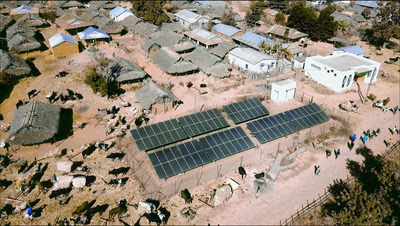South Africa’s free press has been largely successful at resisting efforts by the Chinese government to influence its content, say analysts, affirming a recent study by the U.S.-based think tank Freedom House.
“In South Africa, we have a deep historical suspicion of state media,” said Anton Harber, professor of journalism at the University of the Witwatersrand in Johannesburg.
South Africa’s wariness of state media, he said, stems from the country’s legacy of apartheid, the former state policy of racial segregation and discrimination that ended in 1994. Under apartheid, the media was censored.
“SA’s media is resilient and will always be skeptical when it comes to certain issues being shaped in a certain line of thought,” said Reggy Moalusi, executive director of the South African National Editors’ Forum.
The Freedom House report, titled “Beijing’s Global Media Influence 2022,” said South Africans as a whole, including journalists, are highly skeptical of Chinese state narratives. It said that, despite success by the Chinese government in building ties with the ruling African National Congress party, “coverage of China in South African media remains overall diverse … and often critical of the Chinese government.”
Areas of concern
Even with a democratic government and free press, the Chinese government still attempts to influence South Africa’s media environment, according to the2022 findings by Freedom House, which studied China’s media influence in 30 countries around the world from January 2019 to December 2021.
A private Chinese company with links to the Chinese Communist Party (CPP), StarTimes Group has invested 20 percent in local satellite provider StarSat, which offers Chinese state media television channels, the report said.
Another example cited in the report is South Africa’s Independent Media group, which publishes some 20 newspapers in the country. Since 2013, the group has been 20 percent owned by a Chinese consortium whose shareholders include state media. Its digital version, Independent Online, is the second most-read news site in the country.
Independent Media regularly publishes content from Chinese newswire Xinhua as well as Chinese state perspectives. “None of its outlets carry much negative commentary on China,” Freedom House said.
The company’s outlets published 16 articles, interviews and speeches by the Chinese ambassador and consul generals between 2020 and 2021, the report found. It also gives print space to local South African academics and political figures who support Beijing’s line.
Its foreign editor wrote an op-ed during the pandemic with false claims about COVID-19’s origins. Independent Media journalists have attended media junkets to China and one freelancer told Freedom House researchers that topics for articles and related links are sometimes directly provided by the Chinese embassy.
One example of China’s apparent influence on independent media took place in 2018 when columnist Azad Essa was abruptly let go after writing an article condemning Beijing’s treatment of the Uyghur Muslims.
When contacted by VOA for comment, the group’s editor-in-chief Aziz Hartley responded, “Editors have complete autonomy over their respective publications and their reporters are bound by the principles of unbiased, ethical and objective reporting.”
China’s efforts to influence the media landscape in South Africa were shown to have slowed in recent years, the report found.
The other side
Shao Hesong, second secretary at the Chinese embassy in Washington, referred questions to the Chinese embassy in South Africa, which did not reply to repeated requests for comment.
In a July op-ed published by state media China Daily, Dennis Munene, executive director of the Nairobi-based China-Africa Center at the Africa Policy Institute, made a case for more cooperation between China and African media.
Under the Chinese government’s China-Africa Vision 2035 program, he said, China and Africa “plan to strengthen cooperation in news coverage, creation of audiovisual content, training of media professionals and media technologies.” He argued there is the need for “more in-depth media exchanges’” and said Beijing “can develop technological tools for fact-checking on issues related to Sino-Africa relations.”
Africa findings
While South Africa has a high level of resilience against the Chinese government’s influence due to its diverse media landscape, the study found, the other African nations studied were a mixed bag.
“Our research found that Beijing is trying some of the same tactics in Africa as it does in Western countries, such as signing content-sharing agreements, paid advertorials, or placing ambassador op-eds,” Angeli Datt, a senior research analyst at Freedom House, told VOA.
In Nigeria, attempts at influence from China were “very high” — the fourth highest of all 30 countries surveyed — and while there was some resilience, it was less robust than in the other three. The Chinese embassy in Nigeria has reportedly contacted editors and even paid journalists not to cover negative stories, according to Freedom House.
In Kenya, there were “high” efforts by China to influence the media, but the East African country also had a “notable” level of resilience. For example, a Chinese state-owned company threatened to sue a Kenyan newspaper, The Standard, over its investigative reporting on abuses at a railway run by the firm. The paper refused to retract the story, and the Chinese embassy canceled its advertising with the paper.
Global media influence
Of the 30 countries studied from around the world, Beijing’s efforts at influencing the media were deemed “high” or “very high” in 16 of them, and only half of all those surveyed were found to be resilient to the messaging, the other half vulnerable.
“The Chinese government, under the leadership of President Xi Jinping, is accelerating a massive campaign to influence media outlets and news consumers around the world,” the report said.
Source: Voice of America




 de LeddarTech a été primée dans la catégorie « Détection et perception » lors de l’événement Tech.AD USA le 14 novembre 2022 à Détroit.
de LeddarTech a été primée dans la catégorie « Détection et perception » lors de l’événement Tech.AD USA le 14 novembre 2022 à Détroit.